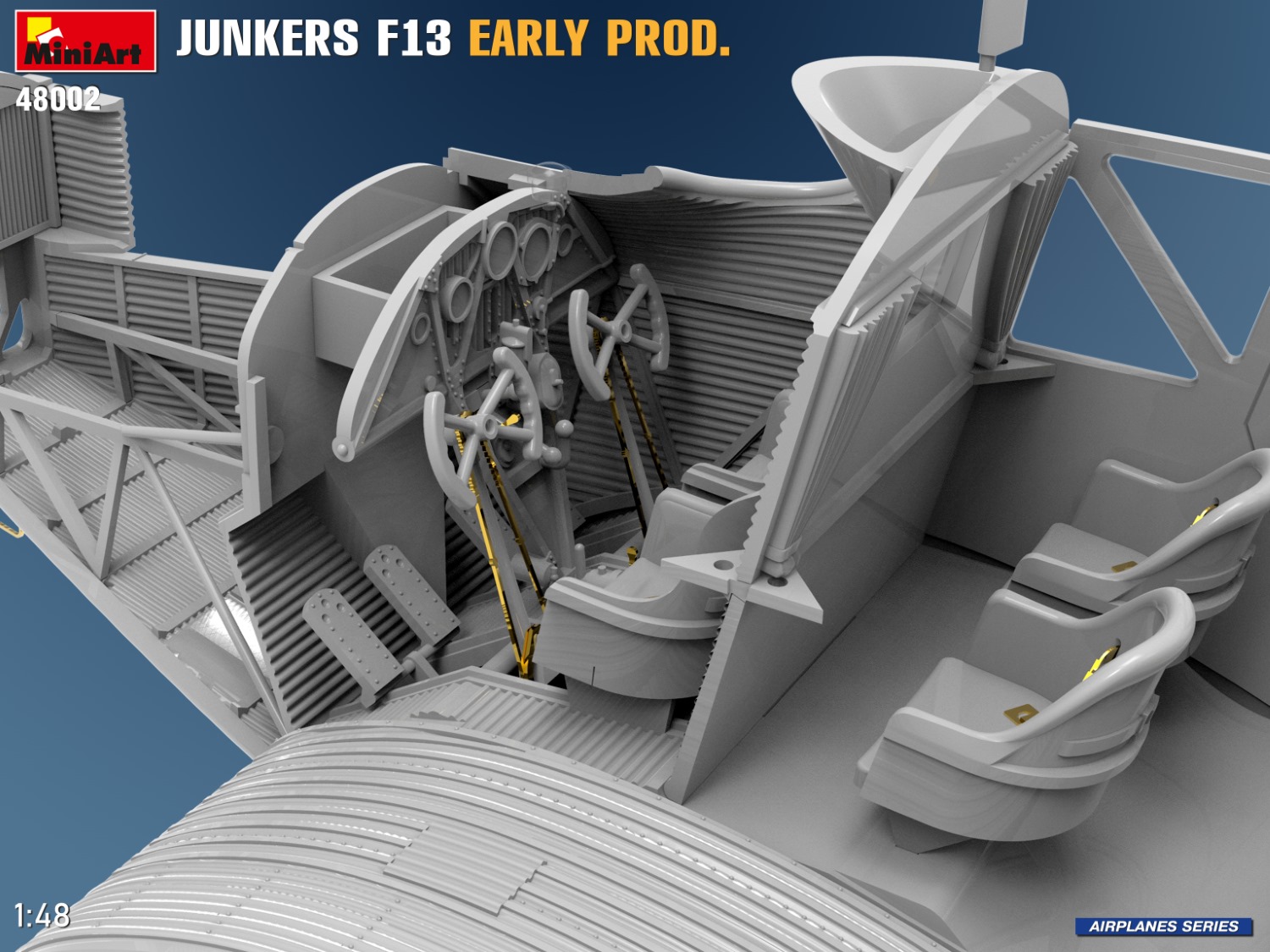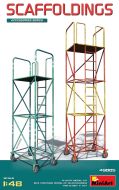Miniart 1/48 Junkers F13 Early Prod # 48002
Discover the Legacy of Aviation with Junkers F13 Early Production 1/48 scale!
Introducing the iconic Junkers F13, the world’s first all-metal transport aircraft.
This detailed 1/48 scale model captures the pioneering and innovative design of the early 20th-century aviation era.
Model represents historic aircraft’s essence, offering Modelers an opportunity to recreate a vital point in aviation history.
- Authentic Details: Experience the unique corrugated surface of the Junkers F13.
- High-Quality Components: The kit features high-quality plastic parts.
- Detailed Interior and Engine: Accurate representation of the cockpit and engine compartments.
- Decals Included: 3 Decal options, providing historical accuracy and visual appeal.
- PE Parts Included: Enhance your model with included photo-etched parts for additional detailization.
- This MiniArt model kit is perfect for both seasoned modelers and aviation enthusiasts looking to explore the fascinating world of early passenger aircraft. Add a touch of history to your collection with the Junkers F13 Early Production model.
 Spread the cost with Paypal Credit
0% for 24 months available on orders over £199
Spread the cost with Paypal Credit
0% for 24 months available on orders over £199
 Spread the cost with Klarna
0% for 24 months available on orders over £199
Spread the cost with Klarna
0% for 24 months available on orders over £199
![]()
The Junkers F13 was a revolutionary aircraft and the world’s first all-metal commercial airplane.
Introduced by German manufacturer Junkers in 1919, it set new standards in aviation design and comfort and paved the way for modern airliners.
The early production models of the F13 were unique for their time, showcasing technological and engineering advancements that would influence aircraft development for decades.
All-Metal Construction:
- The Junkers F13 was the first aircraft to use an all-metal construction, with a duralumin skin that gave it durability and reduced weight compared to wood-and-fabric designs common at the time. This made the F13 resilient against weather and damage, essential for early aviation reliability.
- The aircraft's design was based on a cantilever wing structure with no external bracing, which was not only innovative but also reduced aerodynamic drag, allowing for better performance.
Engine and Performance:
- Early production models of the F13 were typically powered by a 185-horsepower BMW IIIa engine, though later models were fitted with different engines for enhanced performance.
- The F13 could reach a cruising speed of approximately 160 km/h (99 mph) and had a range of around 1,300 kilometers (808 miles), impressive for an aircraft of its class and era.
- Its operational ceiling was around 5,000 meters (16,400 feet), which allowed it to fly above most weather systems for greater passenger comfort and safety.
Passenger and Crew Accommodations:
- The F13 could carry up to four passengers in an enclosed, heated cabin—a rare luxury in the early 20th century, as most airplanes were open-cockpit designs.
- The pilot and co-pilot, however, sat in an open cockpit, giving them a good view for navigation and landings but also exposing them to the elements.
- The cabin had windows and comfortable seating, which helped attract early airline passengers by making flights more pleasant and safer compared to previous aircraft designs.
Role and Significance:
- The Junkers F13 was primarily used as a commercial passenger plane and quickly became popular with early airlines, particularly in Europe and North America.
- It also served in roles such as mail and cargo transport and was adapted by some operators for military and exploration purposes.
- The F13 became the backbone of several airlines, including Lufthansa, and helped launch commercial air travel as a viable industry.
Legacy and Influence:
- With over 300 units produced by the end of its production run in the 1930s, the F13 demonstrated the advantages of metal construction, which would become the standard in future aviation.
- The F13’s success encouraged other manufacturers to adopt similar designs, leading to more advanced commercial and military aircraft throughout the 1920s and 1930s.
- Today, the Junkers F13 is celebrated as a pioneering achievement in aviation, and several replicas and restored models exist to honor its legacy.
Summary
The Junkers F13 early production models were groundbreaking, embodying advanced technology and the transition from experimental flight to commercial aviation.
Its all-metal design, comfortable passenger accommodations, and role in launching the first commercial airline routes make it one of the most important aircraft in aviation history.


Did you know we are the UK's largest GodHand Tools stockist and official UK distributor!
Check out their amazing Ultimate Nipper 5.0, which is the best Nipper on the market.
All Godhand tools are available for next-day delivery.
| SKU | MIN48002 |
|---|---|
| Manufacturer | MiniArt |
| Scale | 1/48 |
| EAN | 5906852927135 |
| Short Description | Discover the Legacy of Aviation with Junkers F13 Early Production 1/48 scale! Introducing the iconic Junkers F13, the world’s first all-metal transport aircraft. This detailed 1/48 scale model captures the pioneering and innovative design of the early 20th-century aviation era. Model represents historic aircraft’s essence, offering Modelers an opportunity to recreate a vital point in aviation history. - Authentic Details: Experience the unique corrugated surface of the Junkers F13. |
-
 Miniart 1/48 Wooden Barrels # 49014Special Price £12.59 was £13.99 Save 10%
Miniart 1/48 Wooden Barrels # 49014Special Price £12.59 was £13.99 Save 10% -
 MiniArt 1/48 Field Workshop # 49012Special Price £15.29 was £16.99 Save 10%
MiniArt 1/48 Field Workshop # 49012Special Price £15.29 was £16.99 Save 10% -
 Miniart 1/48 Plastic Barrels & Cans # 49010Special Price £12.59 was £13.99 Save 10%
Miniart 1/48 Plastic Barrels & Cans # 49010Special Price £12.59 was £13.99 Save 10% -
 Miniart 1/48 Modern Oil Drums (200l) # 49009Special Price £12.59 was £13.99 Save 10%
Miniart 1/48 Modern Oil Drums (200l) # 49009Special Price £12.59 was £13.99 Save 10% -
 Miniart 1/48 Cable Spools # 49008Special Price £12.59 was £13.99 Save 10%
Miniart 1/48 Cable Spools # 49008Special Price £12.59 was £13.99 Save 10% -
 Miniart 1/48 Fuel & Oil Drums 1930-50s # 49007Special Price £12.59 was £13.99 Save 10%
Miniart 1/48 Fuel & Oil Drums 1930-50s # 49007Special Price £12.59 was £13.99 Save 10% -
 Miniart 1/48 Marston Mat Landing Strip w/t Barrels # 49019Special Price £21.59 was £23.99 Save 10%
Miniart 1/48 Marston Mat Landing Strip w/t Barrels # 49019Special Price £21.59 was £23.99 Save 10% -
 Miniart 1/48 P-47D-28RA Thunderbolt Pacific Theater # 48022Special Price £40.49 was £44.99 Save 10%
Miniart 1/48 P-47D-28RA Thunderbolt Pacific Theater # 48022Special Price £40.49 was £44.99 Save 10% -
 Miniart 1/48 Thunderbolt Mk. II Royal Air Force (Advanced Kit) # 48012Special Price £53.99 was £59.99 Save 10%
Miniart 1/48 Thunderbolt Mk. II Royal Air Force (Advanced Kit) # 48012Special Price £53.99 was £59.99 Save 10% -
 Miniart 1/48 Marston Mat Landing Strip # 49017Special Price £21.59 was £23.99 Save 10%
Miniart 1/48 Marston Mat Landing Strip # 49017Special Price £21.59 was £23.99 Save 10% -
 Miniart 1/48 P-47D-28RE Thunderbolt Free French Air Force # 48015Special Price £40.49 was £44.99 Save 10%
Miniart 1/48 P-47D-28RE Thunderbolt Free French Air Force # 48015Special Price £40.49 was £44.99 Save 10% -
 MiniArt 1/48 Scaffoldings # 49005Special Price £13.49 was £14.99 Save 10%
MiniArt 1/48 Scaffoldings # 49005Special Price £13.49 was £14.99 Save 10% -
 Miniart 1/48 Wooden Pallet Set # 49016Special Price £12.59 was £13.99 Save 10%
Miniart 1/48 Wooden Pallet Set # 49016Special Price £12.59 was £13.99 Save 10% -
 Miniart 1/48 P-47D-30RA Thunderbolt Advanced Kit # 48029Special Price £53.99 was £59.99 Save 10%
Miniart 1/48 P-47D-30RA Thunderbolt Advanced Kit # 48029Special Price £53.99 was £59.99 Save 10% -
 Miniart 1/48 Garage Workshop # 49011Special Price £15.29 was £16.99 Save 10%
Miniart 1/48 Garage Workshop # 49011Special Price £15.29 was £16.99 Save 10% -
 Miniart 1/48 Tool Set # 49013Special Price £15.29 was £16.99 Save 10%
Miniart 1/48 Tool Set # 49013Special Price £15.29 was £16.99 Save 10% -
 Miniart 1/48 Wooden Barrels # 49014Special Price £12.59 was £13.99 Save 10%
Miniart 1/48 Wooden Barrels # 49014Special Price £12.59 was £13.99 Save 10% -
 MiniArt 1/48 Field Workshop # 49012Special Price £15.29 was £16.99 Save 10%
MiniArt 1/48 Field Workshop # 49012Special Price £15.29 was £16.99 Save 10% -
 Miniart 1/48 Plastic Barrels & Cans # 49010Special Price £12.59 was £13.99 Save 10%
Miniart 1/48 Plastic Barrels & Cans # 49010Special Price £12.59 was £13.99 Save 10% -
 Miniart 1/48 Modern Oil Drums (200l) # 49009Special Price £12.59 was £13.99 Save 10%
Miniart 1/48 Modern Oil Drums (200l) # 49009Special Price £12.59 was £13.99 Save 10% -
 Miniart 1/48 Cable Spools # 49008Special Price £12.59 was £13.99 Save 10%
Miniart 1/48 Cable Spools # 49008Special Price £12.59 was £13.99 Save 10% -
 Miniart 1/48 Fuel & Oil Drums 1930-50s # 49007Special Price £12.59 was £13.99 Save 10%
Miniart 1/48 Fuel & Oil Drums 1930-50s # 49007Special Price £12.59 was £13.99 Save 10% -
 Miniart 1/48 Marston Mat Landing Strip w/t Barrels # 49019Special Price £21.59 was £23.99 Save 10%
Miniart 1/48 Marston Mat Landing Strip w/t Barrels # 49019Special Price £21.59 was £23.99 Save 10% -
 Miniart 1/48 P-47D-28RA Thunderbolt Pacific Theater # 48022Special Price £40.49 was £44.99 Save 10%
Miniart 1/48 P-47D-28RA Thunderbolt Pacific Theater # 48022Special Price £40.49 was £44.99 Save 10% -
 Miniart 1/48 Thunderbolt Mk. II Royal Air Force (Advanced Kit) # 48012Special Price £53.99 was £59.99 Save 10%
Miniart 1/48 Thunderbolt Mk. II Royal Air Force (Advanced Kit) # 48012Special Price £53.99 was £59.99 Save 10% -
 Miniart 1/48 Marston Mat Landing Strip # 49017Special Price £21.59 was £23.99 Save 10%
Miniart 1/48 Marston Mat Landing Strip # 49017Special Price £21.59 was £23.99 Save 10% -
 Miniart 1/48 P-47D-28RE Thunderbolt Free French Air Force # 48015Special Price £40.49 was £44.99 Save 10%
Miniart 1/48 P-47D-28RE Thunderbolt Free French Air Force # 48015Special Price £40.49 was £44.99 Save 10% -
 MiniArt 1/48 Scaffoldings # 49005Special Price £13.49 was £14.99 Save 10%
MiniArt 1/48 Scaffoldings # 49005Special Price £13.49 was £14.99 Save 10% -
 Miniart 1/48 Wooden Pallet Set # 49016Special Price £12.59 was £13.99 Save 10%
Miniart 1/48 Wooden Pallet Set # 49016Special Price £12.59 was £13.99 Save 10% -
 Miniart 1/48 P-47D-30RA Thunderbolt Advanced Kit # 48029Special Price £53.99 was £59.99 Save 10%
Miniart 1/48 P-47D-30RA Thunderbolt Advanced Kit # 48029Special Price £53.99 was £59.99 Save 10% -
 Miniart 1/48 Garage Workshop # 49011Special Price £15.29 was £16.99 Save 10%
Miniart 1/48 Garage Workshop # 49011Special Price £15.29 was £16.99 Save 10% -
 Miniart 1/48 Tool Set # 49013Special Price £15.29 was £16.99 Save 10%
Miniart 1/48 Tool Set # 49013Special Price £15.29 was £16.99 Save 10% -
 Miniart 1/48 Wooden Barrels # 49014Special Price £12.59 was £13.99 Save 10%
Miniart 1/48 Wooden Barrels # 49014Special Price £12.59 was £13.99 Save 10% -
 MiniArt 1/48 Field Workshop # 49012Special Price £15.29 was £16.99 Save 10%
MiniArt 1/48 Field Workshop # 49012Special Price £15.29 was £16.99 Save 10% -
 Miniart 1/48 Plastic Barrels & Cans # 49010Special Price £12.59 was £13.99 Save 10%
Miniart 1/48 Plastic Barrels & Cans # 49010Special Price £12.59 was £13.99 Save 10% -
 Miniart 1/48 Modern Oil Drums (200l) # 49009Special Price £12.59 was £13.99 Save 10%
Miniart 1/48 Modern Oil Drums (200l) # 49009Special Price £12.59 was £13.99 Save 10% -
 Miniart 1/48 Cable Spools # 49008Special Price £12.59 was £13.99 Save 10%
Miniart 1/48 Cable Spools # 49008Special Price £12.59 was £13.99 Save 10% -
 Miniart 1/48 Fuel & Oil Drums 1930-50s # 49007Special Price £12.59 was £13.99 Save 10%
Miniart 1/48 Fuel & Oil Drums 1930-50s # 49007Special Price £12.59 was £13.99 Save 10%



























